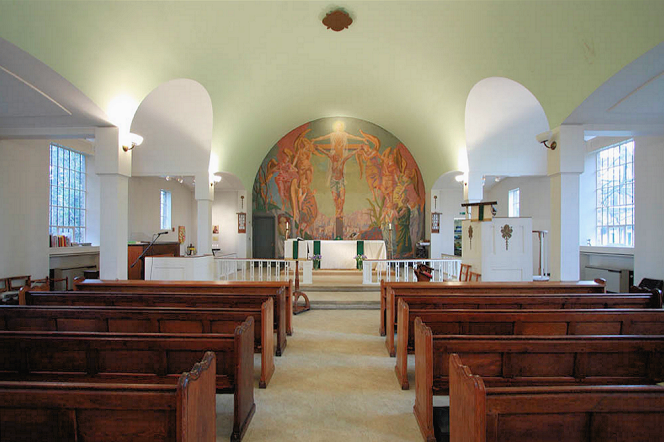Downtown
Downtown, Southwark
A riverside locality in east Rotherhithe, covering the area centred on Holy Trinity church, north of Greenland Dock

Sometime in the 19th century ‘Downtown’ evolved as a local name for the south-eastern end of Rotherhithe Street. It didn’t appear on any maps until much later (and then rarely) and its residents constituted an isolated community. In 1904 the social reformer George Sims wrote a series of six Strand Magazine articles in which he visited “strange [London] quarters inhabited by strange people” – and he devoted one to Downtown.
The Downtown group of estates were 1930s schemes of mainly three-storey deck-access flats and maisonettes built in a classic municipal style and providing homes for workers at the Surrey Docks. Their surroundings were wholly dock-related: riverside wharves, pontoons and piers to the east and inland docks, yards and warehouses to the west.
In the Downtown locality, Lady Dock (and, until it was filled in, Acorn Pond) occupied most of the area west of what is now Salter Road, with the larger (but narrow) Russia Dock further west.
“The rising and swivelling bridges were the only land access to what had become known many years ago as ‘Downtown’ by the residents, mainly dockers and factory workers who lived in the old tenement blocks and two-up, two-down houses and prided themselves on their isolation, and the area was cut off when the bridges were operating and a freighter was passing into or out of the dock system in the centre of the island. The dockyards were always stacked full of timber brought from Russia, Finland and Scandinavia, and in the local pubs in Downtown Rotherhithe weird and wonderful concoctions of drinks could be had and a dozen different languages heard.”
Harry Bowling, As Time Goes By (1998)
Downtown was very badly affected by bombing in the Second World War. The early-Victorian Trinity church was destroyed by German bombing on the first night of the Blitz and the present Holy Trinity church (shown in the photo above*) was built on its site in the late 1950s. Andie Byrnes’ excellent Rotherhithe Blog has a full history of both churches.
The subsequent decline of the docks hastened the fate of the estate. Many of the homes had become vandalised squats by the time they came within the purview of the London Docklands Development Corporation in the early 1980s.
Under the terms of the ‘Downtown package’, Southwark council and the LDDC worked with several housing associations and developers to fill in the disused docks, demolish the associated structures, build new townhouses and apartments and refurbish viable older buildings. All the cul-de-sacs west of Salter Road were created at this time, where there had formerly been no housing at all.
More recently, Barratt London has redeveloped much of the north side of Downton Road as Redwood Park.
